Along an 85-mile stretch of road in Louisiana, residents have seven times the risk of cancer than the national average, have been diagnosed with chronic health conditions, and babies are born underweight at three times the national average.
This road between Baton Rouge and New Orleans – on the banks of the Mississippi River – has been dubbed ‘Cancer Alley’, and people with houses along it blame the high number of diseases in the place where they live.
The area is home to approximately 200 fossil fuel and petrochemical operations—the largest concentration of these facilities in the Western Hemisphere.
Earlier this year, Human Rights Watch published a report describes the high rates of disease in the area, which the inhabitants have referred to as ‘the corridor of death’.
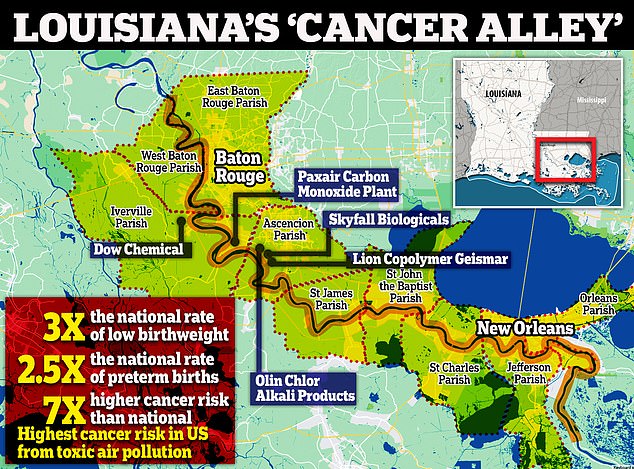
Along an 85-mile stretch of road in Louisiana, residents have seven times the risk of cancer than the national average
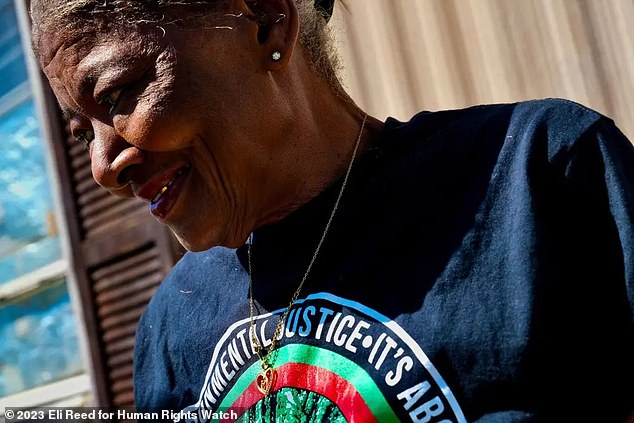

Janice Ferchaud, 66, underwent a mastectomy after she was diagnosed with breast cancer. She attributed her cancer and the deaths of family members to the pollution from the plants
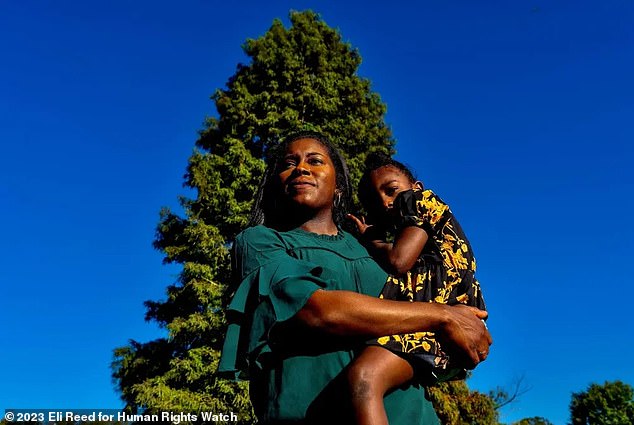

Ascension Parish resident Kaitlyn Joshua has suffered from chronic asthma since childhood
The report accuses state and federal regulators of failing to properly monitor the industry and says the Louisiana Department of Environmental Quality has yet to address the dangers of fossil fuels and does not enforce minimum standards set by the government to protect the environment and human health.
Additionally, the Environmental Protection Agency (EPA) has failed to monitor Louisiana’s compliance with laws and mandates—and as a result, is failing to protect the environment and local residents.
For years, residents along the road have suffered from higher rates of cancer, reproductive, maternal and newborn health complications, and respiratory disease.
The HRW report found that the area of the United States with the highest risk of cancer from industrial air pollution — more than seven times the national average — is in Cancer Alley.
Babies here are born underweight at three times the national average and are born prematurely at 2.5 times the national average.
HRW focused on nine parishes in Cancer Alley: Ascension, East Baton Rouge, Iberville, Jefferson, Orleans, St. Charles, St. James, St. John the Baptist and West Baton Rouge.
Together, these are home to more than 1.56 million people.
Sharon Lavigne, 71, lives in Welcome, a community in St James Parish, about an hour west of New Orleans along the 85-mile stretch.
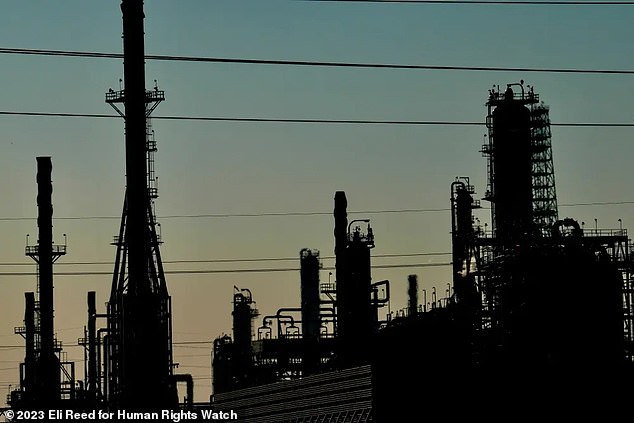

An industrial facility in Louisiana’s Cancer Alley, which has the highest concentration of such facilities in the Western Hemisphere
She told HRW: ‘We are dying from breathing industrial pollution. I feel like it’s a death sentence. As if we are cremated but not burned.’
Nearby, 66-year-old Janice Ferchaud underwent a mastectomy after she was diagnosed with breast cancer. She told HRW that she wants people to know what the residents of Cancer Alley are going through.
Ms. Ferchaud attributed her cancer and the deaths of family members to the pollution from the plants.
Robert Taylor, 83, also a resident along Cancer Alley, spoke of ‘dozens’ of family members and friends, including his wife and mother, who have been diagnosed with or died from cancer.
Along with neighbors’ stories of prostate, liver, and breast cancer, mothers spoke of stillbirths, infertility, childhood asthma, bronchitis, and chronic sinus infections.
Kaitlyn Joshua, who lives in Ascension Parish and has suffered from chronic asthma since childhood, told HRW that her doctor said: ‘Kaitlyn, this is where you live. It’s the air quality. You will have to move from there’.
Also from Ascension Parish, Dominic Kruger said: ‘Everyone is sick and dying and it’s just getting worse.’
Angie Roberts, 57, from St James, has lived in the area for 28 years. In 2019, she was diagnosed with breast cancer and underwent a mastectomy. Recently, her doctor found lumps in her other breast and she developed the autoimmune disorder multiple sclerosis.
Fossil fuel and petrochemical emissions may increase the risk of autoimmune diseases such as MS, according to the report.
Mrs Roberts said: ‘Who would want to live here now? I’m going to die here.’
Parents also told HRW about keeping their children home from school and indoors because of poor air quality.
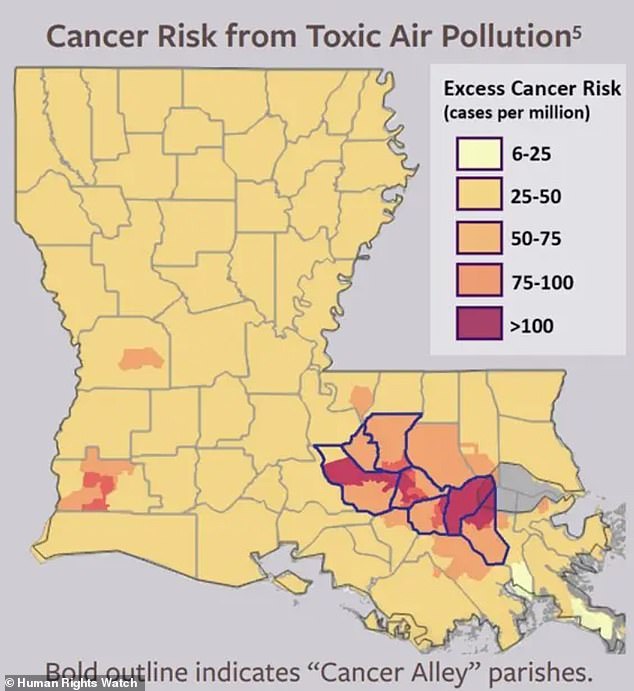



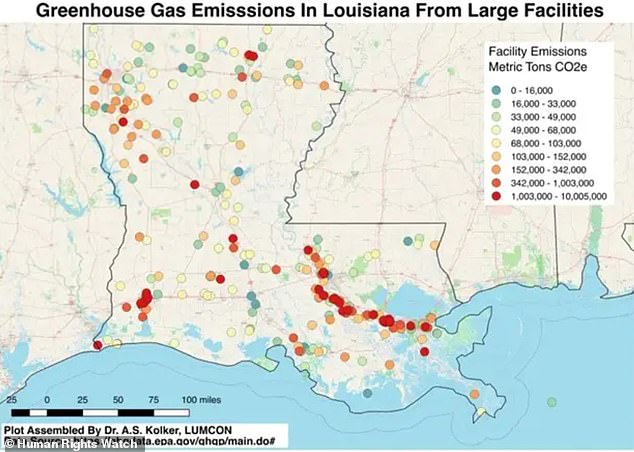

Louisiana’s Cancer Alley is far from the only area where residents are at risk.
A clean air task force report by 2022, nearly 14 million people in the United States found an increased risk of cancer from toxic pollutants.
These people across 236 counties in 21 states face a cancer risk that exceeds the EPA’s one-in-a-million threshold ‘level of concern’.
In 33 counties the cancer risk exceeds one in 250,000 and in three this risk is one in 100,000
Breast cancer campaign added that when women are exposed to cancer-causing chemicals and endocrine-disrupting chemicals, it can affect their risk of breast cancer, especially when exposed during crucial developmental times, such as puberty.
A 2021 Harvard examination found that more than 8 million people died in 2018 as a result of fossil fuel pollution, accounting for 18 percent of worldwide deaths.
And according to the World Health Organization, people exposed to air pollution are more likely to suffer from stroke, heart disease, lung cancer, respiratory infections and a myriad of other diseases.
WHO reported that environmental and household air pollution are linked to 7 million premature deaths each year.
For the report, HRW researchers focused on emissions from plants near playgrounds, schools, retirement homes, homes, farms and businesses.
Researchers spoke to 37 residents along Cancer Alley between September 2022 and January 2024.
Antonia Juhasz, Senior Researcher on Fossil Fuels at HRW said: ‘The fossil fuel and petrochemical industry has created a “victim zone” in Louisiana.
“The failure of state and federal authorities to properly regulate the industry has dire consequences.”
In 2022, the United Nations Special Rapporteur on Human Rights and the Environment also called these areas of Louisiana ‘victim zones’ and considered them to be among the most polluted and dangerous places on Earth.
And at least 19 more facilities are planned for Cancer Alley.
In 2020 alone, two-thirds of all of Louisiana’s greenhouse emissions were produced by 150 plants in Cancer Alley.
Following their findings, HRW researchers called on local, state and federal governments to support laws regulating fossil fuel or petrochemical facilities.
Legislators should limit the areas where these facilities are built and require their operators to “implement practices and procedures that protect human rights in frontline communities, including by adopting and effectively enforcing regulations and taking immediate and comprehensive action to deter and remedy violations.” ”
Specifically, in Louisiana, the report said the state Department of Environmental Quality should deny permits to build in communities already overburdened with pollution, and the EPA should order the facilities to cease operations until they can meet standards set by the Clean Air Act.

